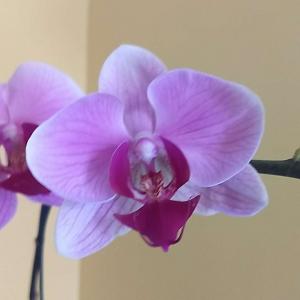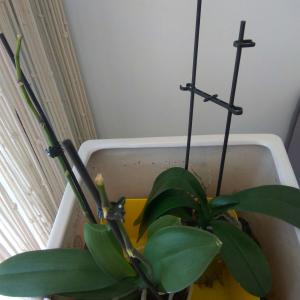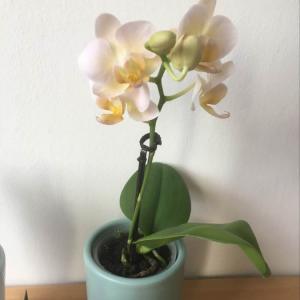成长记
LaneyTea
2017年11月04日

I now added "Phalaenopsis Orchid" in my "garden"
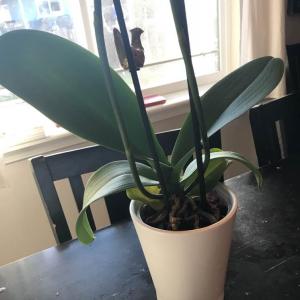

0
0
Jabandit:Aka bought an orchid at Home Depot lol
成长记
Estefania Pereira
2017年10月16日

i have just noticed black orchid is also getting taller, as you can see new leaves are growing too, very happy with how they are turning out

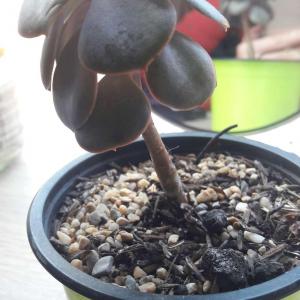


0
0
成长记
Estefania Pereira
2017年10月10日

black orchid is doing better than before, they seemed to be underwatered so i have been watering them more, still think they need more time though
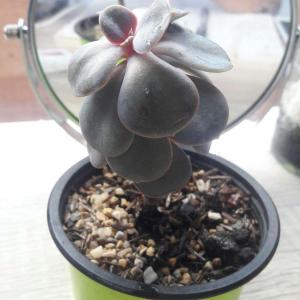

0
0
家苗铭凯:好像是菲欧娜
文章
Dummer. ゛☀
2017年10月01日

Scientific Name
Sansevieria zeylanica (L.) Willd.
Common Names
Cylindrical Snake Plant, African Spear, Spear Sansevieria, Spear Orchid, Skyline Spear Sansevieria
Synonyms
Acyntha cylindrica, Cordyline cylindrica, Sansevieria angolensis, Sansevieria livingstoniae
Scientific Classification
Family: Asparagaceae
Subfamily: Crassuloideae
Genus: Sansevieria
Description
Sansevieria cylindrica is a very striking succulent with striped, round leaves that are smooth and a green-gray in color. A single leaf is up to 1.2 inches (3 cm) thick and grows to a height between 3 feet (90 cm) and 7 feet (2.1 m). It grows fan-shaped, with its stiff leaves growing from a basal rosette. If grown in bright enough light this plant can produce a 3 foot (90 cm) spike-like raceme of pink-budded white flowers.
How to Grow and Care
Place Sansevierias in moderately bright or filtered light. Good locations include a spot in front of a north-facing window or in front of a bright, sunny window covered by a sheer curtain. Although the plant tolerates low light, bright light brings out the colors in the leaves. However, intense light may cause the edges of the leaves to turn yellow. Allow the soil to dry completely before watering, and then water deeply until water drips through the drainage hole. Allow the pot to drain and then discard water that remains in the saucer. Never allow the soil to become soggy and never let the pot stand in water. Water sparingly throughout the winter.
Like most succulent plants that store water in their leaves, Sansevieria rots quickly in excessively wet soil. Place Sansevieria in average room temperatures.
Sansevieria zeylanica (L.) Willd.

Common Names
Cylindrical Snake Plant, African Spear, Spear Sansevieria, Spear Orchid, Skyline Spear Sansevieria
Synonyms
Acyntha cylindrica, Cordyline cylindrica, Sansevieria angolensis, Sansevieria livingstoniae
Scientific Classification
Family: Asparagaceae
Subfamily: Crassuloideae
Genus: Sansevieria

Description
Sansevieria cylindrica is a very striking succulent with striped, round leaves that are smooth and a green-gray in color. A single leaf is up to 1.2 inches (3 cm) thick and grows to a height between 3 feet (90 cm) and 7 feet (2.1 m). It grows fan-shaped, with its stiff leaves growing from a basal rosette. If grown in bright enough light this plant can produce a 3 foot (90 cm) spike-like raceme of pink-budded white flowers.

How to Grow and Care
Place Sansevierias in moderately bright or filtered light. Good locations include a spot in front of a north-facing window or in front of a bright, sunny window covered by a sheer curtain. Although the plant tolerates low light, bright light brings out the colors in the leaves. However, intense light may cause the edges of the leaves to turn yellow. Allow the soil to dry completely before watering, and then water deeply until water drips through the drainage hole. Allow the pot to drain and then discard water that remains in the saucer. Never allow the soil to become soggy and never let the pot stand in water. Water sparingly throughout the winter.

Like most succulent plants that store water in their leaves, Sansevieria rots quickly in excessively wet soil. Place Sansevieria in average room temperatures.
3
2
文章
Dummer. ゛☀
2017年09月29日

Scientific Name
Phalaenopsis amabilis (L.) Blume

Common Names
Moon Orchid, Moth Orchid, The Lovely Phalaenopsis
Synonyms
Cymbidium amabile, Epidendrum amabile, Phalaenopsis amabilis subsp. amabilis, Phalaenopsis aphrodite var. gloriosa, Phalaenopsis elisabethae, Phalaenopsis gloriosa, Phalaenopsis grandiflora, Phalaenopsis rimestadiana, Synadena amabilis
Scientific Classification
Family: Orchidaceae
Subfamily: Epidendroideae
Genus: Phalaenopsis
Subgenus: Phalaenopsis

Flower
Color: White
Bloom Time: Spring to summer
Description
Phalaenopsis amabilis is the national flower of Indonesia. It has a short stem. The shiny green leaves are up to 20 inches (50 cm) long and up to 4 inches (10 cm) wide and vary from oblong to elliptic at the base and obtuse, minutely, at the tip or apex. The flower is showy, membranous, white, the lip, (the unpared petals of an orchid) which is three-lobed, and the callus are a variety of yellow and red depending on the individual plant. It bloom from spring to summer with several flowers, up to 4 inches (10 cm) in diameter and more.

How to Grow and Care
Phalaenopsis are generally very rewarding plants. They are not demanding and, in the right conditions, they will reward the grower with months of showy blooms. It is vitally important, however, that water never be allowed to rest in the growing tip of the plant. This will cause the new leaves to rot, and the plant will die. Thus, they should only be watered in the morning. As with all Orchids, the higher the humidity and temperature, the greater the need for turbulent air flow to prevent rot, fungus and diseases. Successful growth means finding the right balance between humidity, temperature, light and air flow.
Phalaenopsis can be grown in most Orchid potting media, including chunks of pine bark, clay aggregate pellets, charcoal, perlite, sphagnum moss, and styrofoam. They can also be grown in hanging baskets or mounted on slabs in a greenhouse-type environment. As with all Epiphytic Orchids, they should be planted in free-draining containers. Repot Phalaenopsis in spring, after the bloom is done. Adult Phalaenopsis can often go for two years or more before they need to be repotted.
Origin
Native of northern Australia, Indonesia, Papua New Guinea, the Philippines and New Britain occuring at elevations up to 600 meters in rainforests on trunks and branches overhanging rivers.
Phalaenopsis amabilis (L.) Blume

Common Names
Moon Orchid, Moth Orchid, The Lovely Phalaenopsis
Synonyms
Cymbidium amabile, Epidendrum amabile, Phalaenopsis amabilis subsp. amabilis, Phalaenopsis aphrodite var. gloriosa, Phalaenopsis elisabethae, Phalaenopsis gloriosa, Phalaenopsis grandiflora, Phalaenopsis rimestadiana, Synadena amabilis
Scientific Classification
Family: Orchidaceae
Subfamily: Epidendroideae
Genus: Phalaenopsis
Subgenus: Phalaenopsis

Flower
Color: White
Bloom Time: Spring to summer
Description
Phalaenopsis amabilis is the national flower of Indonesia. It has a short stem. The shiny green leaves are up to 20 inches (50 cm) long and up to 4 inches (10 cm) wide and vary from oblong to elliptic at the base and obtuse, minutely, at the tip or apex. The flower is showy, membranous, white, the lip, (the unpared petals of an orchid) which is three-lobed, and the callus are a variety of yellow and red depending on the individual plant. It bloom from spring to summer with several flowers, up to 4 inches (10 cm) in diameter and more.

How to Grow and Care
Phalaenopsis are generally very rewarding plants. They are not demanding and, in the right conditions, they will reward the grower with months of showy blooms. It is vitally important, however, that water never be allowed to rest in the growing tip of the plant. This will cause the new leaves to rot, and the plant will die. Thus, they should only be watered in the morning. As with all Orchids, the higher the humidity and temperature, the greater the need for turbulent air flow to prevent rot, fungus and diseases. Successful growth means finding the right balance between humidity, temperature, light and air flow.
Phalaenopsis can be grown in most Orchid potting media, including chunks of pine bark, clay aggregate pellets, charcoal, perlite, sphagnum moss, and styrofoam. They can also be grown in hanging baskets or mounted on slabs in a greenhouse-type environment. As with all Epiphytic Orchids, they should be planted in free-draining containers. Repot Phalaenopsis in spring, after the bloom is done. Adult Phalaenopsis can often go for two years or more before they need to be repotted.
Origin
Native of northern Australia, Indonesia, Papua New Guinea, the Philippines and New Britain occuring at elevations up to 600 meters in rainforests on trunks and branches overhanging rivers.
0
0
文章
Dummer. ゛☀
2017年09月29日

Scientific Name
Grammatophyllum speciosum Blume

Common Names
Tiger Orchid, Giant Orchid, Sugar Cane Orchid, Queen of the Orchids
Synonyms
Grammatophyllum fastuosum, Grammatophyllum giganteum, Grammatophyllum macranthum, Pattonia macrantha
Scientific Classification
Family: Orchidaceae
Subfamily: Epidendroideae
Tribe: Cymbidieae
Subtribe: Cymbidiinae
Genus: Grammatophyllum

Flower
Color: Yellow with maroon or dark red spots
Bloom Time: Only once every 2 to 4 years
Description
Grammatophyllum speciosum is an epiphytic and occasionally a lithophytic plant, forming spectacular root bundles. Its cylindrical pseudobulbs can grow up to 8.2 feet (2.5 m) long. Each raceme can grow up to 10 feet (3 m), bearing up to eighty flowers, each up to 4 inches (10 cm) wide. The flowers are yellow colored with maroon or dark red spots. These flowers are remarkable, since the lowest flowers have no lip and these flowers function as osmophores for the entire inflorescence and continue to emit chemical scent to attract pollinators as flowers open in succession. It blooms only once every 2 to 4 years. This orchid can, however, remain in bloom for up to two months. It is listed by the Guinness Book of World Records as the world’s tallest orchid, with specimens recorded up to 25 feet (7.6 m) in height.

How to Grow and Care
Grammatophyllums grow well in moderate light intensity. Morning sun is best, until about noon. Observation of the leaf structure can be your best guide to the correct light conditions for which a type is particularly suited. Lime green colored foliage is an indication of proper light. Dark green foliage, while very attractive, is not conducive to the plant reaching it’s full blooming potential. Yellow colored foliage indicates too much light. In very mild climates, most members of this can be grown out of doors, with protection from the hot summer sun, and the colder nights of winter.
The ideal annual temperature range for most members of the genus Grammatophyllum are 75 to 85 °F (24 to 30 °C) during the day and 55 to 60 °F (13 to 16 °C) at night. Plants will tolerate temperatures to 45 °F (10 °C) and up to 100 °F (38 °C) for short periods. At higher temperatures, air circulation and humidity must be increased or damage can occur.
Origin
Native to New Guinea, Indonesia, Malaysia and Philippines, growing in crotches of large trees on exposed areas of the lowland tropical rainforest.
Grammatophyllum speciosum Blume

Common Names
Tiger Orchid, Giant Orchid, Sugar Cane Orchid, Queen of the Orchids
Synonyms
Grammatophyllum fastuosum, Grammatophyllum giganteum, Grammatophyllum macranthum, Pattonia macrantha
Scientific Classification
Family: Orchidaceae
Subfamily: Epidendroideae
Tribe: Cymbidieae
Subtribe: Cymbidiinae
Genus: Grammatophyllum

Flower
Color: Yellow with maroon or dark red spots
Bloom Time: Only once every 2 to 4 years
Description
Grammatophyllum speciosum is an epiphytic and occasionally a lithophytic plant, forming spectacular root bundles. Its cylindrical pseudobulbs can grow up to 8.2 feet (2.5 m) long. Each raceme can grow up to 10 feet (3 m), bearing up to eighty flowers, each up to 4 inches (10 cm) wide. The flowers are yellow colored with maroon or dark red spots. These flowers are remarkable, since the lowest flowers have no lip and these flowers function as osmophores for the entire inflorescence and continue to emit chemical scent to attract pollinators as flowers open in succession. It blooms only once every 2 to 4 years. This orchid can, however, remain in bloom for up to two months. It is listed by the Guinness Book of World Records as the world’s tallest orchid, with specimens recorded up to 25 feet (7.6 m) in height.

How to Grow and Care
Grammatophyllums grow well in moderate light intensity. Morning sun is best, until about noon. Observation of the leaf structure can be your best guide to the correct light conditions for which a type is particularly suited. Lime green colored foliage is an indication of proper light. Dark green foliage, while very attractive, is not conducive to the plant reaching it’s full blooming potential. Yellow colored foliage indicates too much light. In very mild climates, most members of this can be grown out of doors, with protection from the hot summer sun, and the colder nights of winter.
The ideal annual temperature range for most members of the genus Grammatophyllum are 75 to 85 °F (24 to 30 °C) during the day and 55 to 60 °F (13 to 16 °C) at night. Plants will tolerate temperatures to 45 °F (10 °C) and up to 100 °F (38 °C) for short periods. At higher temperatures, air circulation and humidity must be increased or damage can occur.
Origin
Native to New Guinea, Indonesia, Malaysia and Philippines, growing in crotches of large trees on exposed areas of the lowland tropical rainforest.
0
0
文章
Dummer. ゛☀
2017年09月29日

Scientific Name
Grammatophyllum scriptum (L.) Blume

Common Names
Bell Orchid, Written Grammatophyllum
Synonyms
Epidendrum scriptum (basionym), Cymbidium scriptum, Epidendrum papilionaceum, Gabertia scripta, Grammatophyllum boweri, Grammatophyllum celebicum, Grammatophyllum leopardinum, Grammatophyllum seegerianum, Vanda scripta
Scientific Classification
Family: Orchidaceae
Subfamily: Epidendroideae
Tribe: Cymbidieae
Subtribe: Cymbidiinae
Genus: Grammatophyllum

Flower
Color: Green with dark brown
Bloom Time: Summer
Description
Grammatophyllum scriptum is a well-known species of orchid, with pseudobulbs up to 8 inches (20 cm), from which originate 3 to 4 stout leaves up to 3.3 feet (1 m) long. The flowers are generally up to 1.8 inches (4.5 cm) wide, green with dark brown markings and held in racemes of up to 150 blooms.

How to Grow and Care
Grammatophyllums grow well in moderate light intensity. Morning sun is best, until about noon. Observation of the leaf structure can be your best guide to the correct light conditions for which a type is particularly suited. Lime green colored foliage is an indication of proper light. Dark green foliage, while very attractive, is not conducive to the plant reaching it’s full blooming potential. Yellow colored foliage indicates too much light. In very mild climates, most members of this can be grown out of doors, with protection from the hot summer sun, and the colder nights of winter.
The ideal annual temperature range for most members of the genus Grammatophyllum are 75 to 85 °F (24 to 30 °C) during the day and 55 to 60 °F (13 to 16 °C) at night. Plants will tolerate temperatures to 45 °F (10 °C) and up to 100 °F (38 °C) for short periods. At higher temperatures, air circulation and humidity must be increased or damage can occur.
Origin
Native to south east Asia and is found in low-lying coastal areas.
Grammatophyllum scriptum (L.) Blume

Common Names
Bell Orchid, Written Grammatophyllum
Synonyms
Epidendrum scriptum (basionym), Cymbidium scriptum, Epidendrum papilionaceum, Gabertia scripta, Grammatophyllum boweri, Grammatophyllum celebicum, Grammatophyllum leopardinum, Grammatophyllum seegerianum, Vanda scripta
Scientific Classification
Family: Orchidaceae
Subfamily: Epidendroideae
Tribe: Cymbidieae
Subtribe: Cymbidiinae
Genus: Grammatophyllum

Flower
Color: Green with dark brown
Bloom Time: Summer
Description
Grammatophyllum scriptum is a well-known species of orchid, with pseudobulbs up to 8 inches (20 cm), from which originate 3 to 4 stout leaves up to 3.3 feet (1 m) long. The flowers are generally up to 1.8 inches (4.5 cm) wide, green with dark brown markings and held in racemes of up to 150 blooms.

How to Grow and Care
Grammatophyllums grow well in moderate light intensity. Morning sun is best, until about noon. Observation of the leaf structure can be your best guide to the correct light conditions for which a type is particularly suited. Lime green colored foliage is an indication of proper light. Dark green foliage, while very attractive, is not conducive to the plant reaching it’s full blooming potential. Yellow colored foliage indicates too much light. In very mild climates, most members of this can be grown out of doors, with protection from the hot summer sun, and the colder nights of winter.
The ideal annual temperature range for most members of the genus Grammatophyllum are 75 to 85 °F (24 to 30 °C) during the day and 55 to 60 °F (13 to 16 °C) at night. Plants will tolerate temperatures to 45 °F (10 °C) and up to 100 °F (38 °C) for short periods. At higher temperatures, air circulation and humidity must be increased or damage can occur.
Origin
Native to south east Asia and is found in low-lying coastal areas.
0
0
文章
Dummer. ゛☀
2017年09月29日

Scientific Name
Ophrys scolopax Cav.

Common Names
Woodcock Bee-orchid, Woodcock Orchid
Synonyms
Ophrys scolopax subsp. scolopax, Ophrys abchasica, Ophrys apiformis, Ophrys arachnites var. scolopax, Ophrys atropos, Ophrys bremifera, Ophrys bullata, Ophrys ceto, Ophrys corbariensis, Ophrys fuciflora subsp. scolopax, Ophrys gerstlaueri, Ophrys hippocratis, Ophrys holoserica subsp. scolopax, Ophrys hygrophila, Ophrys karadenizensis, Ophrys mycenensis, Ophrys orphanidea, Ophrys santonica, Ophrys schelkownikowii
Scientific Classification
Family: Orchidaceae
Subfamily: Orchidoideae
Tribe: Orchidinae
Genus: Ophrys

Flower
Color: Pink and dark brown
Bloom Time: From March to beginning of May
Description
Ophrys scolopax grows from underground tubers. Leaves typically start to appear above ground in late autumn and are often beginning to yellow by the time the flowers appear, between March and June in their native habitats. The flower spike is very variable in height, usually up to 20 inches (50 cm) tall, but occasionally up to 3 feet (90 cm). The number of flowers is equally variable, with as few as two or as many as 15 or even more. Each flower has the standard structure for the genus. The flowers usually have pink sepals and petals but occasionally specimens with green or white sepals and petals are found. The flower lip is deeply lobed and dark brown. The shape of the speculum is variable but it is generally dark blue bordered with white.
Hardiness
USDA hardiness zone 8a to 10b: from 10 °F (−12.2 °C) to 40 °F (+4.4 °C).

How to Grow and Care
Generally, orchids can be grouped into three temperature categories: cool, warm, and intermediate. Buy a high-low thermometer to measure the temperature range in your orchid location. After that, choosing a suitable orchid is simple. As with light, some orchids easily adapt to more than one temperature range.
Most orchids we grow indoors come from the tropics, and most parts of the tropics are much more humid than the average living room. Orchids grow better if you can boost the humidity in their immediate growing area by grouping your plants together, or placing them on a dry well. Create a dry well by placing plastic lattice or pebbles on a tray, then adding water to just below the lattice or top of the pebbles. Place your potted plants on top of the lattice or pebbles.
Anyone who has ever watered an orchid knows that most of what you pour in runs out almost immediately through the bottom of the pot. Because orchids are potted in bark mix rather than potting soil, they need to be watered differently.
Origin
It is found around the Mediterranean and the Middle East, from Morocco and Portugal to Hungary and Iran.
Ophrys scolopax Cav.

Common Names
Woodcock Bee-orchid, Woodcock Orchid
Synonyms
Ophrys scolopax subsp. scolopax, Ophrys abchasica, Ophrys apiformis, Ophrys arachnites var. scolopax, Ophrys atropos, Ophrys bremifera, Ophrys bullata, Ophrys ceto, Ophrys corbariensis, Ophrys fuciflora subsp. scolopax, Ophrys gerstlaueri, Ophrys hippocratis, Ophrys holoserica subsp. scolopax, Ophrys hygrophila, Ophrys karadenizensis, Ophrys mycenensis, Ophrys orphanidea, Ophrys santonica, Ophrys schelkownikowii
Scientific Classification
Family: Orchidaceae
Subfamily: Orchidoideae
Tribe: Orchidinae
Genus: Ophrys

Flower
Color: Pink and dark brown
Bloom Time: From March to beginning of May
Description
Ophrys scolopax grows from underground tubers. Leaves typically start to appear above ground in late autumn and are often beginning to yellow by the time the flowers appear, between March and June in their native habitats. The flower spike is very variable in height, usually up to 20 inches (50 cm) tall, but occasionally up to 3 feet (90 cm). The number of flowers is equally variable, with as few as two or as many as 15 or even more. Each flower has the standard structure for the genus. The flowers usually have pink sepals and petals but occasionally specimens with green or white sepals and petals are found. The flower lip is deeply lobed and dark brown. The shape of the speculum is variable but it is generally dark blue bordered with white.
Hardiness
USDA hardiness zone 8a to 10b: from 10 °F (−12.2 °C) to 40 °F (+4.4 °C).

How to Grow and Care
Generally, orchids can be grouped into three temperature categories: cool, warm, and intermediate. Buy a high-low thermometer to measure the temperature range in your orchid location. After that, choosing a suitable orchid is simple. As with light, some orchids easily adapt to more than one temperature range.
Most orchids we grow indoors come from the tropics, and most parts of the tropics are much more humid than the average living room. Orchids grow better if you can boost the humidity in their immediate growing area by grouping your plants together, or placing them on a dry well. Create a dry well by placing plastic lattice or pebbles on a tray, then adding water to just below the lattice or top of the pebbles. Place your potted plants on top of the lattice or pebbles.
Anyone who has ever watered an orchid knows that most of what you pour in runs out almost immediately through the bottom of the pot. Because orchids are potted in bark mix rather than potting soil, they need to be watered differently.
Origin
It is found around the Mediterranean and the Middle East, from Morocco and Portugal to Hungary and Iran.
0
0
文章
Dummer. ゛☀
2017年09月29日

Scientific Name
Ophrys apifera Huds.

Common Names
Bee Orchid
Synonyms
Arachnites apiferus, Ophrys albiflora, Ophrys aquisgranensis, Ophrys arachnites, Ophrys asilifera, Ophrys austriaca, Ophrys botteronii, Ophrys chlorantha, Ophrys epeirophora, Ophrys friburgensis, Ophrys holoserica, Ophrys immaculata, Ophrys integra, Ophrys jurana, Ophrys mangini, Ophrys oestrifera, Ophrys purpurea, Ophrys ripaensis, Ophrys rostrata, Ophrys saraepontana, Ophrys scolopax subsp. oestrifera, Ophrys scolopax var. oestrifera, Ophrys trollii, Orchis apifera, Orchis holoserica, Orchis oestrifera
Scientific Classification
Family: Orchidaceae
Subfamily: Orchidoideae
Tribe: Orchidinae
Genus: Ophrys

Flower
Color: Brownish-red with yellow markings
Bloom Time: Mid April to July
Description
Ophrys apifera is a perennial herbaceous plant up to 20 inches (50 cm) tall. This hardy orchid develops small rosettes of leaves in autumn. They continue to grow slowly during winter. Basal leaves are ovate or oblong-lanceolate, upper leaves and bracts are ovate-lanceolate and sheathing. The plant blooms from mid April to July, producing a spike composed from 1 to 12 flowers. The flowers have large sepals, with a central green rib and their color varies from white to pink, while petals are short, pubescent, yellow to greenish. The labellum is trilobed, with two pronounced humps on the hairy lateral lobes, the median lobe is hairy and similar to the abdomen of a bee. It is quite variable in the pattern of coloration, but usually brownish-red with yellow markings. The gynostegium is at right angles, with an elongated apex.

How to Grow and Care
Generally, orchids can be grouped into three temperature categories: cool, warm, and intermediate. Buy a high-low thermometer to measure the temperature range in your orchid location. After that, choosing a suitable orchid is simple. As with light, some orchids easily adapt to more than one temperature range.
Most orchids we grow indoors come from the tropics, and most parts of the tropics are much more humid than the average living room. Orchids grow better if you can boost the humidity in their immediate growing area by grouping your plants together, or placing them on a dry well. Create a dry well by placing plastic lattice or pebbles on a tray, then adding water to just below the lattice or top of the pebbles. Place your potted plants on top of the lattice or pebbles.
Anyone who has ever watered an orchid knows that most of what you pour in runs out almost immediately through the bottom of the pot. Because orchids are potted in bark mix rather than potting soil, they need to be watered differently.
Origin
It is a widespread across central and southern Europe, as well as North Africa and the Middle East.
Ophrys apifera Huds.

Common Names
Bee Orchid
Synonyms
Arachnites apiferus, Ophrys albiflora, Ophrys aquisgranensis, Ophrys arachnites, Ophrys asilifera, Ophrys austriaca, Ophrys botteronii, Ophrys chlorantha, Ophrys epeirophora, Ophrys friburgensis, Ophrys holoserica, Ophrys immaculata, Ophrys integra, Ophrys jurana, Ophrys mangini, Ophrys oestrifera, Ophrys purpurea, Ophrys ripaensis, Ophrys rostrata, Ophrys saraepontana, Ophrys scolopax subsp. oestrifera, Ophrys scolopax var. oestrifera, Ophrys trollii, Orchis apifera, Orchis holoserica, Orchis oestrifera
Scientific Classification
Family: Orchidaceae
Subfamily: Orchidoideae
Tribe: Orchidinae
Genus: Ophrys

Flower
Color: Brownish-red with yellow markings
Bloom Time: Mid April to July
Description
Ophrys apifera is a perennial herbaceous plant up to 20 inches (50 cm) tall. This hardy orchid develops small rosettes of leaves in autumn. They continue to grow slowly during winter. Basal leaves are ovate or oblong-lanceolate, upper leaves and bracts are ovate-lanceolate and sheathing. The plant blooms from mid April to July, producing a spike composed from 1 to 12 flowers. The flowers have large sepals, with a central green rib and their color varies from white to pink, while petals are short, pubescent, yellow to greenish. The labellum is trilobed, with two pronounced humps on the hairy lateral lobes, the median lobe is hairy and similar to the abdomen of a bee. It is quite variable in the pattern of coloration, but usually brownish-red with yellow markings. The gynostegium is at right angles, with an elongated apex.

How to Grow and Care
Generally, orchids can be grouped into three temperature categories: cool, warm, and intermediate. Buy a high-low thermometer to measure the temperature range in your orchid location. After that, choosing a suitable orchid is simple. As with light, some orchids easily adapt to more than one temperature range.
Most orchids we grow indoors come from the tropics, and most parts of the tropics are much more humid than the average living room. Orchids grow better if you can boost the humidity in their immediate growing area by grouping your plants together, or placing them on a dry well. Create a dry well by placing plastic lattice or pebbles on a tray, then adding water to just below the lattice or top of the pebbles. Place your potted plants on top of the lattice or pebbles.
Anyone who has ever watered an orchid knows that most of what you pour in runs out almost immediately through the bottom of the pot. Because orchids are potted in bark mix rather than potting soil, they need to be watered differently.
Origin
It is a widespread across central and southern Europe, as well as North Africa and the Middle East.
0
0
文章
Dummer. ゛☀
2017年09月28日

Some of the most popular orchid plants among home growers are Dendrobium orchids These showy flowers are relatively easy to grow, with a central long stem and an attractive spray of flowers that can last up to four weeks.
There are many Dendrobium varieties, and each one has slightly different growing conditions. Luckily, with all the types of Dendrobium orchids to choose from, there is likely to be one that fits your home environment perfectly.
Dendrobium is sort of the catch-all of orchid species. When you look for Dendrobium orchid info, you can find whole books devoted to each of the different types of Dendrobium orchids that can fall into this category. In general, though, you can separate them in a few different groups.
Sheer beginners will love Nobile orchids. These hybrids go dormant for a couple of months in the winter, losing some of their leaves in the process. These plants can have up to 50 blooms on one stem, making for a stunning floral display. Growers have perfected the Nobile hybrids so closely that they can even cause them to bloom for any requested holiday. If you’re looking for an orchid with lots of helpful information available about it, this is the one to choose.
Growing Conditions and General Care
Although there is a huge variety from which to choose, when it comes to learning how to grow Dendrobium orchids, there are two important rules that they all follow.
First, they like to live in little pots with their roots crowded into a tiny area. If you try to be nice and give them room to spread out, the roots are likely to stay too moist and begin to rot. If you don’t like the look of a large plant growing in a ridiculously small pot, camouflage it in a larger planter.
The other way to care for Dendrobium orchids is to give them as much bright light as possible. This doesn’t mean sticking them in the desert sunlight, but a south-facing window in the house is the place where they will thrive. In almost all cases, when your Dendrobium orchid isn’t flowering, it’s a case of not enough sunlight.

There are many Dendrobium varieties, and each one has slightly different growing conditions. Luckily, with all the types of Dendrobium orchids to choose from, there is likely to be one that fits your home environment perfectly.

Dendrobium is sort of the catch-all of orchid species. When you look for Dendrobium orchid info, you can find whole books devoted to each of the different types of Dendrobium orchids that can fall into this category. In general, though, you can separate them in a few different groups.
Sheer beginners will love Nobile orchids. These hybrids go dormant for a couple of months in the winter, losing some of their leaves in the process. These plants can have up to 50 blooms on one stem, making for a stunning floral display. Growers have perfected the Nobile hybrids so closely that they can even cause them to bloom for any requested holiday. If you’re looking for an orchid with lots of helpful information available about it, this is the one to choose.

Growing Conditions and General Care
Although there is a huge variety from which to choose, when it comes to learning how to grow Dendrobium orchids, there are two important rules that they all follow.
First, they like to live in little pots with their roots crowded into a tiny area. If you try to be nice and give them room to spread out, the roots are likely to stay too moist and begin to rot. If you don’t like the look of a large plant growing in a ridiculously small pot, camouflage it in a larger planter.

The other way to care for Dendrobium orchids is to give them as much bright light as possible. This doesn’t mean sticking them in the desert sunlight, but a south-facing window in the house is the place where they will thrive. In almost all cases, when your Dendrobium orchid isn’t flowering, it’s a case of not enough sunlight.
0
0
文章
Dummer. ゛☀
2017年09月27日

America’s most popular flower is also one of the very oldest flowers in cultivation. There are over 2,000 different rose varieties to lure us with their history and fragrance. This is because the rose, like the orchid, cross-breeds readily—a trait exploited first by nature, and then by horticulturalists. Today, we can choose from old-fashioned favorites, as well as modern varieties that are the result of intensive breeding programs throughout the world. The rose is a flower with a rich past, and an exciting future.
Finding your way through the rose’s large extended family can be both confusing and intimidating. Damasks, musks, gallicas, centifolias, hybrid perpetuals, Bourbons, hybrid teas, ramblers and climbers—even the most distinguished rosarians have a difficult time determining which rose is which.
Tracing the history of a particular rose can be a fascinating adventure, but it is hardly an exact science. The old roses have cross-bred so many times, and so many varieties have been lost to time, that it is often impossible to uncover the exact parentage. If you are one of the many who become possessed by roses, you may eventually find it important to know the difference between a gallica and a Bourbon. But until that point, our advice is not to worry about it. The important thing is to select a rose that you find beautiful, and that suits your garden.
Roses are usually grouped into one of two broad categories: old roses and modern roses. Old roses are those varieties discovered or developed prior to the introduction of the hybrid tea rose in 1867. But like everything else in the world of roses, when it comes to determining how a particular rose should be classified, it’s not always crystal clear.
It is generally agreed that “old roses” include species or wild roses; albas; Bourbons; moss roses; China roses; Noisettes; Portland roses; rugosa roses; Scotch roses; centifolias; hybrid pimpinellifolias; damasks; gallicas; hybrid perpetuals; tea roses; and musk roses. Those classified as modern varieties are hybrid teas; floribundas; polyanthas; grandifloras; miniatures and dwarfs; modern shrub and landscape roses; climbers and ramblers; and rugosa hybrids.
Why choose an old-fashioned rose over a modern hybrid? Many of the old varieties offer more fragrance, more complex and interesting blooms, greater disease resistance, easier care and more interesting forms. But modern roses can offer all-season blooms, and a much broader range of colors and flower forms. Some are also far more cold- hardy and disease-resistant than any of the old-fashioned varieties.
How to Select a Rose
There are thousands of beautiful roses, far more than any of us will ever have the opportunity to see, much less grow. When choosing a rose for your garden, there are five considerations that should make the selection process easier.
Growth Habit
Though roses are usually planted for their flowers, it is important to know what the plant as well as the flowers will look like, in order to determine where it will fit in your garden.
Hybrid teas and floribundas usually grow no more than 2 to 3 feet (60 to 90 cm) high. Their form is coarse, and hardly very appealing, but they do have the ability to produce an abundance of flowers throughout the growing season. The hybrid tea has large, single blooms on long, stiff stems, whereas the floribunda has slightly smaller clusters of blooms on stems that are not as stiff.
Miniature roses have tiny flowers, and may be only 10 to 36 inches (25 to 90 cm) tall. Dwarf roses grow up to 2 feet (60 cm) high, and their flowers are produced in clusters. Shrub roses, including both the old-fashioned and the modern types, and ground-cover or landscape roses, are generally large and leafy.
Climbers and ramblers grow from 7 feet to 30 feet (2.1 to 9 m) in length, and most of them benefit from some support. Standards are roses that are trained into a tree-like form with a single stem and a rounded bush or weeping display of flowers on top.
Hardiness
Northern gardeners need to know exactly what zone a rose is hardy to. Southern gardeners must also watch to see what zones are recommended for each particular variety, as some roses perform very poorly in hot and/or humid weather. Read the catalogs carefully and, if possible, purchase your roses from a local or regional grower. They will be able to advise you from experience about how a particular variety will perform in your area.
Bloom Time
Many roses, especially the old-fashioned varieties, have just one flush of blooms per year. Will you be satisfied with a cloud of heavenly pink blossoms for three weeks in June, or do you need your rose to bloom all summer long? This consideration may narrow your choices very quickly.
Disease-resistance
Selecting a disease-resistant rose is the single most effective way to avoid problems and the need for chemicals. You might start by considering some of the old rose varieties, many of which have natural disease resistance. You can also look to many of the modern roses, which are now being bred for improved disease resistance. Hybrid teas are notoriously disease-prone, and seem to lure every insect pest from miles around. They can be difficult to grow without an arsenal of chemical dusts and sprays.
Stem Length
This may seem like an odd consideration, but it’s important if you are growing roses for cutting. The traditional florist rose is a hybrid tea, and it is the only type that flowers on a long, stiff stem. All other roses have shorter, weaker stems, which gives them a more casual—some believe more beautiful—presence in a vase.
Growing Conditions and General Care
Roses are rather particular, and you should be aware of the growing conditions and care necessary to keep them happy.
Site: For most abundant blooms and greatest vigor, they need to receive 6 to 8 hours of direct sunlight each day. In hot climates, they will appreciate receiving protection from the most intense afternoon sun. In cool climates, a fence or a warm south- or west-facing wall can add enough extra warmth to boost flower production and reduce winter damage.
Soils: Roses need good drainage and a rich, moisture-retentive soil, with a pH between 6.5 and 7. If your soil is heavy and wet, you may want to consider planting your roses in raised beds. Compost should be added to create a loose texture with a high organic content. For help correcting a pH imbalance, read Building Healthy Soil.
Water: Roses require more water than most other landscape plantings, especially during the first year as the plant is getting its roots established. The best way to water your roses is with drip irrigation. It concentrates the water at the root zone where it is needed, and keeps the foliage dry to minimize disease problems. A good, thick layer of organic mulch will help conserve moisture, reduce weeds, and encourage healthy root growth. As the mulch breaks down, it will also add organic matter to the soil.
Fertilizer: Roses are heavy feeders, and will benefit from a steady supply of nitrogen, phosphorus and potassium. You can provide these nutrients with either liquid or granular fertilizers, at a ratio of approximately 5-8-5. In most cases, regular applications of compost, rotted manure, fish emulsion and seaweed extracts will provide roses with all the nutrients they need. These organic amendments also help to moderate pH imbalances and stimulate beneficial soil life. Other organic amendments favored by rose growers include greensand, black rock phosphate and alfalfa meal.
Pruning: Dead, weak and sickly stems can lead to disease problems. Pruning these away will increase air circulation to the center of the plant and minimize fungus problems. Pruning also stimulates new growth, and allows you to shape the plant in a pleasing manner. Spent flowers should be removed during the growing season to encourage reblooming. Use a scissor-action pruner for the cleanest cuts.
Winter protection: If possible, select rose varieties that are hardy for your growing zone; ones that can survive the winter with no special protection. In cold climates, hybrid teas and floribundas, as well as some of the smaller shrub roses, will benefit from a little extra insulation.
Once you have had several weeks of below-freezing temperatures, cover the base of the rose with 12 inches (30 cm) of soil or mulch, and then cover the canes with straw, leaves, pine boughs or even foam insulation. Climbing varieties can be wrapped right on their supports, or you can lay them on the ground and cover the canes with straw or brush. In severely cold climates, hybrid teas are sometimes partially dug up, laid down onto the soil, and the entire plant is then covered with more soil or mulch.
Pests and diseases: Prevention is the best way to avoid pest and disease problems. Start with disease-resistant varieties, keep plants in healthy condition (well fertilized and well watered), maintain good air circulation, keep foliage dry, and remove any diseased foliage or spent flowers. For persistent pest problems, you can use botanical insecticides such as sabadilla, neem, rotenone, and pyrethrins. These are broad-spectrum controls, meaning they kill many types of insects, both good and bad. Though they are organic, these controls are potent and should be used sparingly.

Finding your way through the rose’s large extended family can be both confusing and intimidating. Damasks, musks, gallicas, centifolias, hybrid perpetuals, Bourbons, hybrid teas, ramblers and climbers—even the most distinguished rosarians have a difficult time determining which rose is which.
Tracing the history of a particular rose can be a fascinating adventure, but it is hardly an exact science. The old roses have cross-bred so many times, and so many varieties have been lost to time, that it is often impossible to uncover the exact parentage. If you are one of the many who become possessed by roses, you may eventually find it important to know the difference between a gallica and a Bourbon. But until that point, our advice is not to worry about it. The important thing is to select a rose that you find beautiful, and that suits your garden.

Roses are usually grouped into one of two broad categories: old roses and modern roses. Old roses are those varieties discovered or developed prior to the introduction of the hybrid tea rose in 1867. But like everything else in the world of roses, when it comes to determining how a particular rose should be classified, it’s not always crystal clear.
It is generally agreed that “old roses” include species or wild roses; albas; Bourbons; moss roses; China roses; Noisettes; Portland roses; rugosa roses; Scotch roses; centifolias; hybrid pimpinellifolias; damasks; gallicas; hybrid perpetuals; tea roses; and musk roses. Those classified as modern varieties are hybrid teas; floribundas; polyanthas; grandifloras; miniatures and dwarfs; modern shrub and landscape roses; climbers and ramblers; and rugosa hybrids.

Why choose an old-fashioned rose over a modern hybrid? Many of the old varieties offer more fragrance, more complex and interesting blooms, greater disease resistance, easier care and more interesting forms. But modern roses can offer all-season blooms, and a much broader range of colors and flower forms. Some are also far more cold- hardy and disease-resistant than any of the old-fashioned varieties.
How to Select a Rose
There are thousands of beautiful roses, far more than any of us will ever have the opportunity to see, much less grow. When choosing a rose for your garden, there are five considerations that should make the selection process easier.

Growth Habit
Though roses are usually planted for their flowers, it is important to know what the plant as well as the flowers will look like, in order to determine where it will fit in your garden.
Hybrid teas and floribundas usually grow no more than 2 to 3 feet (60 to 90 cm) high. Their form is coarse, and hardly very appealing, but they do have the ability to produce an abundance of flowers throughout the growing season. The hybrid tea has large, single blooms on long, stiff stems, whereas the floribunda has slightly smaller clusters of blooms on stems that are not as stiff.

Miniature roses have tiny flowers, and may be only 10 to 36 inches (25 to 90 cm) tall. Dwarf roses grow up to 2 feet (60 cm) high, and their flowers are produced in clusters. Shrub roses, including both the old-fashioned and the modern types, and ground-cover or landscape roses, are generally large and leafy.
Climbers and ramblers grow from 7 feet to 30 feet (2.1 to 9 m) in length, and most of them benefit from some support. Standards are roses that are trained into a tree-like form with a single stem and a rounded bush or weeping display of flowers on top.

Hardiness
Northern gardeners need to know exactly what zone a rose is hardy to. Southern gardeners must also watch to see what zones are recommended for each particular variety, as some roses perform very poorly in hot and/or humid weather. Read the catalogs carefully and, if possible, purchase your roses from a local or regional grower. They will be able to advise you from experience about how a particular variety will perform in your area.
Bloom Time
Many roses, especially the old-fashioned varieties, have just one flush of blooms per year. Will you be satisfied with a cloud of heavenly pink blossoms for three weeks in June, or do you need your rose to bloom all summer long? This consideration may narrow your choices very quickly.

Disease-resistance
Selecting a disease-resistant rose is the single most effective way to avoid problems and the need for chemicals. You might start by considering some of the old rose varieties, many of which have natural disease resistance. You can also look to many of the modern roses, which are now being bred for improved disease resistance. Hybrid teas are notoriously disease-prone, and seem to lure every insect pest from miles around. They can be difficult to grow without an arsenal of chemical dusts and sprays.
Stem Length
This may seem like an odd consideration, but it’s important if you are growing roses for cutting. The traditional florist rose is a hybrid tea, and it is the only type that flowers on a long, stiff stem. All other roses have shorter, weaker stems, which gives them a more casual—some believe more beautiful—presence in a vase.

Growing Conditions and General Care
Roses are rather particular, and you should be aware of the growing conditions and care necessary to keep them happy.
Site: For most abundant blooms and greatest vigor, they need to receive 6 to 8 hours of direct sunlight each day. In hot climates, they will appreciate receiving protection from the most intense afternoon sun. In cool climates, a fence or a warm south- or west-facing wall can add enough extra warmth to boost flower production and reduce winter damage.

Soils: Roses need good drainage and a rich, moisture-retentive soil, with a pH between 6.5 and 7. If your soil is heavy and wet, you may want to consider planting your roses in raised beds. Compost should be added to create a loose texture with a high organic content. For help correcting a pH imbalance, read Building Healthy Soil.
Water: Roses require more water than most other landscape plantings, especially during the first year as the plant is getting its roots established. The best way to water your roses is with drip irrigation. It concentrates the water at the root zone where it is needed, and keeps the foliage dry to minimize disease problems. A good, thick layer of organic mulch will help conserve moisture, reduce weeds, and encourage healthy root growth. As the mulch breaks down, it will also add organic matter to the soil.

Fertilizer: Roses are heavy feeders, and will benefit from a steady supply of nitrogen, phosphorus and potassium. You can provide these nutrients with either liquid or granular fertilizers, at a ratio of approximately 5-8-5. In most cases, regular applications of compost, rotted manure, fish emulsion and seaweed extracts will provide roses with all the nutrients they need. These organic amendments also help to moderate pH imbalances and stimulate beneficial soil life. Other organic amendments favored by rose growers include greensand, black rock phosphate and alfalfa meal.
Pruning: Dead, weak and sickly stems can lead to disease problems. Pruning these away will increase air circulation to the center of the plant and minimize fungus problems. Pruning also stimulates new growth, and allows you to shape the plant in a pleasing manner. Spent flowers should be removed during the growing season to encourage reblooming. Use a scissor-action pruner for the cleanest cuts.

Winter protection: If possible, select rose varieties that are hardy for your growing zone; ones that can survive the winter with no special protection. In cold climates, hybrid teas and floribundas, as well as some of the smaller shrub roses, will benefit from a little extra insulation.
Once you have had several weeks of below-freezing temperatures, cover the base of the rose with 12 inches (30 cm) of soil or mulch, and then cover the canes with straw, leaves, pine boughs or even foam insulation. Climbing varieties can be wrapped right on their supports, or you can lay them on the ground and cover the canes with straw or brush. In severely cold climates, hybrid teas are sometimes partially dug up, laid down onto the soil, and the entire plant is then covered with more soil or mulch.

Pests and diseases: Prevention is the best way to avoid pest and disease problems. Start with disease-resistant varieties, keep plants in healthy condition (well fertilized and well watered), maintain good air circulation, keep foliage dry, and remove any diseased foliage or spent flowers. For persistent pest problems, you can use botanical insecticides such as sabadilla, neem, rotenone, and pyrethrins. These are broad-spectrum controls, meaning they kill many types of insects, both good and bad. Though they are organic, these controls are potent and should be used sparingly.
0
0





